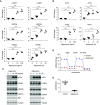ATF4 Mediates Mitochondrial Unfolded Protein Response in Alveolar Epithelial Cells
- PMID: 32551949
- PMCID: PMC7528926
- DOI: 10.1165/rcmb.2020-0107OC
ATF4 Mediates Mitochondrial Unfolded Protein Response in Alveolar Epithelial Cells
Abstract
Although endoplasmic reticulum (ER) unfolded protein response (UPRER) is well known, mitochondrial unfolded protein response (UPRmt) has not been recognized in alveolar epithelial cells. Furthermore, ER stress and mitochondrial dysfunction are frequently encountered in alveolar epithelial cells from an array of lung disorders. However, these two scenarios have been often regarded as separate mechanisms contributing to the pathogeneses. It is unclear whether there is interplay between these two phenomena or an integrator that couples these two signaling cascades in the stressed alveolar epithelial cells from those pathologies. In this study, we defined UPRmt in alveolar epithelial cells and identified ATF4 (activating transcription factor 4), but not ATF5, as the key regulator of UPRmt. We found that UPRER led to UPRmt and mitochondrial dysfunction in an ATF4-dependent manner. In contrast, mitochondrial stresses did not activate UPRER. We found that alveolar epithelial ATF4 and UPRmt were induced in aged mice with experimental pulmonary fibrosis as well as in patients with idiopathic pulmonary fibrosis. Finally, we found that the inducible expression of ATF4 in mouse alveolar epithelial cells aggravated pulmonary UPRmt, lung inflammation, body weight loss, and death upon bleomycin-induced lung injury. In conclusion, ER stress induces ATF4-dependent UPRmt and mitochondrial dysfunction, indicating a novel mechanism by which ER stress contributes to the pathogeneses of a variety of pulmonary disorders.
Keywords: ER stress; alveolar epithelial cell; mitochondrial UPR; pulmonary fibrosis.
Figures








Comment in
-
Lost in Translation: Endoplasmic Reticulum-Mitochondria Crosstalk in Idiopathic Pulmonary Fibrosis.Am J Respir Cell Mol Biol. 2020 Oct;63(4):408-409. doi: 10.1165/rcmb.2020-0273ED. Am J Respir Cell Mol Biol. 2020. PMID: 32716642 Free PMC article. No abstract available.
Similar articles
-
HIF-1α triggers ER stress and CHOP-mediated apoptosis in alveolar epithelial cells, a key event in pulmonary fibrosis.Sci Rep. 2018 Dec 18;8(1):17939. doi: 10.1038/s41598-018-36063-2. Sci Rep. 2018. PMID: 30560874 Free PMC article.
-
ATF4 regulates arsenic trioxide-mediated NADPH oxidase, ER-mitochondrial crosstalk and apoptosis.Arch Biochem Biophys. 2016 Nov 1;609:39-50. doi: 10.1016/j.abb.2016.09.003. Epub 2016 Sep 13. Arch Biochem Biophys. 2016. PMID: 27638049 Free PMC article.
-
ER-tethered stress sensor CREBH regulates mitochondrial unfolded protein response to maintain energy homeostasis.Proc Natl Acad Sci U S A. 2024 Dec 3;121(49):e2410486121. doi: 10.1073/pnas.2410486121. Epub 2024 Nov 26. Proc Natl Acad Sci U S A. 2024. PMID: 39589874 Free PMC article.
-
Emerging evidence for endoplasmic reticulum stress in the pathogenesis of idiopathic pulmonary fibrosis.Am J Physiol Lung Cell Mol Physiol. 2012 Apr 15;302(8):L721-9. doi: 10.1152/ajplung.00410.2011. Epub 2012 Jan 27. Am J Physiol Lung Cell Mol Physiol. 2012. PMID: 22287606 Free PMC article. Review.
-
Stress-responsive regulation of mitochondria through the ER unfolded protein response.Trends Endocrinol Metab. 2014 Oct;25(10):528-37. doi: 10.1016/j.tem.2014.06.007. Epub 2014 Jul 18. Trends Endocrinol Metab. 2014. PMID: 25048297 Review.
Cited by
-
eIF2α phosphorylation-ATF4 axis-mediated transcriptional reprogramming mitigates mitochondrial impairment during ER stress.Mol Cells. 2025 Feb;48(2):100176. doi: 10.1016/j.mocell.2024.100176. Epub 2025 Jan 3. Mol Cells. 2025. PMID: 39756584 Free PMC article.
-
UPRmt and coordinated UPRER in type 2 diabetes.Front Cell Dev Biol. 2022 Sep 16;10:974083. doi: 10.3389/fcell.2022.974083. eCollection 2022. Front Cell Dev Biol. 2022. PMID: 36187475 Free PMC article. Review.
-
Mitochondrial stress induces hepatic stellate cell activation in response to the ATF4/TRIB3 pathway stimulation.J Gastroenterol. 2023 Jul;58(7):668-681. doi: 10.1007/s00535-023-01996-7. Epub 2023 May 7. J Gastroenterol. 2023. PMID: 37150773
-
A model of the aged lung epithelium in idiopathic pulmonary fibrosis.Aging (Albany NY). 2021 Jul 8;13(13):16922-16937. doi: 10.18632/aging.203291. Epub 2021 Jul 8. Aging (Albany NY). 2021. PMID: 34238764 Free PMC article.
-
HDAC1 Promotes Mitochondrial Pathway Apoptosis and Inhibits the Endoplasmic Reticulum Stress Response in High Glucose-Treated Schwann Cells via Decreased U4 Spliceosomal RNA.Neurochem Res. 2024 Oct;49(10):2699-2724. doi: 10.1007/s11064-024-04200-1. Epub 2024 Jun 25. Neurochem Res. 2024. PMID: 38916813
References
-
- Wang M, Kaufman RJ. Protein misfolding in the endoplasmic reticulum as a conduit to human disease. Nature. 2016;529:326–335. - PubMed
-
- Walter P, Ron D. The unfolded protein response: from stress pathway to homeostatic regulation. Science. 2011;334:1081–1086. - PubMed
-
- Clarke HJ, Chambers JE, Liniker E, Marciniak SJ. Endoplasmic reticulum stress in malignancy. Cancer Cell. 2014;25:563–573. - PubMed
-
- Hetz C, Papa FR. The unfolded protein response and cell fate control. Mol Cell. 2018;69:169–181. - PubMed
Publication types
MeSH terms
Substances
Grants and funding
LinkOut - more resources
Full Text Sources

